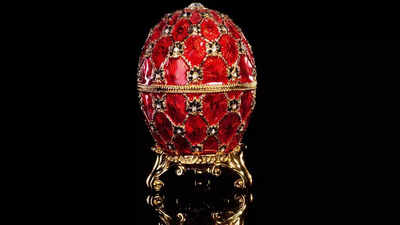- News
- Man discovers $33 Million Fabergé Egg hiding in plain sight on his kitchen counter
Man discovers $33 Million Fabergé Egg hiding in plain sight on his kitchen counter
A man in the United States unknowingly purchased a rare Fabergé egg for $14,000, which turned out to be worth approximately $33 million. The egg, lost since 1903 and historically significant, was an Easter gift from Emperor Alexander III to Empress Marie Feodorovna in 1887 and was confirmed authentic by an expert.
Through the ages, the interest in uncommon and beautiful treasures has caught the attention of collectors, historians, and art lovers. These ancient artifacts and delicate ornaments are extraordinary discoveries that provide a look into the past and tell about the skill and artistry present in the past. Whether found in secret vaults, excavated from abandoned ruins, or uncovered in the most abrupt of locations, these treasures have great cultural and historical value.
Recently something extraordinary was experienced by a man in the United States who bought an egg for $14,000 from an antiques store, not realizing its true value. It was only after the egg had been resting on his kitchen counter for years that he discovered its unexpected worth.
An unidentified man in the United States discovered that he was the owner of an authentic 19th-century Fabergé egg worth some £20 million (about $33 million). According to an Artnet report, the man initially bought the egg for $14,000 from an antique store in the Midwest, unaware of its true value. He had planned to melt down the priceless antique for its gold and the diamonds and sapphires attached to its surface.
In 2012, after the object had been placed on his counter for years, the man decided to Google the word "egg" and the name inscribed on the object, "Vacheron Constantin." This led him to a newspaper article referring to the lost jewel. The man immediately contacted Fabergé expert Kieran McCarthy of jeweler Wartski, who later confirmed its authenticity. Wartski bought the egg on behalf of a collector.
What was special about the egg?

The egg had been lost for decades and had not been publicly seen since 1903. Originally designed by Carl Fabergé, the egg was an Easter gift from Alexander III Emperor to Empress Marie Feodorovna in 1887. The egg was eventually taken by the Bolsheviks during the Russian Revolution in 1917.
The first clue about its existence came in 2011 when researchers found a 1964 catalog from the New York auction house Parke Bernet. The catalog described it as a "Gold Watch in Egg-Form Case," and the auction house sold it for $1,443 to a Southern woman, who then passed away in the early 2000s. The egg is one of 43 Fabergé eggs known to still exist.
What are Fabergé eggs?
Fabergé eggs are a collection of highly ornate jeweled eggs produced by the famous Russian jeweler Peter Carl Fabergé and his atelier. They were created mostly for the Russian imperial family between 1885 and 1917.

The best known of these are the Imperial Easter Eggs that were ordered by Russian Tsars Alexander III and Nicholas II as presents to their wives and mothers. Made of valuable metals such as gold and platinum and set with precious stones like diamonds, rubies, emeralds, and sapphires, Fabergé eggs are famous for their elaborate designs and secret surprises.
Most eggs have miniature portraits, small mechanical models, or delicate sculptures inside them. Of the 50 Imperial Easter Eggs made, 43 are found to still be in existence. These eggs are of huge historical importance, showing the richness and artistry of the Russian imperial court prior to the Russian Revolution of 1917.
End of Article
FOLLOW US ON SOCIAL MEDIA









